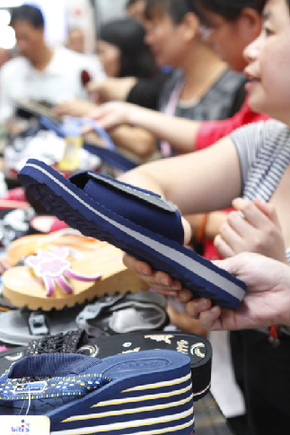Free trade deal lifts business
|
|
|
People bargain for a good price for Vietnamese-made sandals at the China-ASEAN Expo held in late October in Nanning city in Guangxi Zhuang autonomous region. Buoyed by the China-ASEAN Free Trade Area's zero-tariff framework, 1,178 enterprises from the 10 ASEAN economies attended the event, a record number participants in the expo's seven years of history. |
More than 600 years after mariner Zheng He's voyage to Southeast Asia as China's first maritime trade visit to the region, entrepreneurs from these states are now riding the wave of the nation's economic boom and seeking a foothold in the Middle Kingdom.
Fueled by the new free trade zone established in January between China and the Association of Southeast Asian Nations (ASEAN), these business-savvy merchants have gained more steam for their commercial expansion in China.
After patiently waiting for years, Clay Industries Sdn Bhd (CISB), one of Malaysia's largest vitreous porcelain sanitary ware makers under the Claytan Group, has now made its fist foray into the Chinese mainland.
"We immediately made the decision to invest in the Chinese market once the China-ASEAN Free Trade Area (CAFTA) was officially announced early this year. It reduces our tariffs from 10 percent to zero and significantly cuts our operational costs in China," said Andrew Wong, senior manager of Clay Industries' International Market Department.
The trade zone, the world's largest by population with 1.9 billion people and a combined gross domestic product (GDP) of approximately $6.4 trillion in 2009, is expected to help push bilateral trade and investment through providing preferential market access to the two sides' businesses. Most of the goods in the area have become tariff-free since January.
The average tariff on ASEAN's original six members - Indonesia, Thailand, the Philippines, Malaysia, Singapore and Brunei - was slashed from 9.8 percent to 0.6 percent in January 2010.
Benefiting from the agreement, Clay opened its first three stores in Shanghai's Parkson, a Malaysian department store operator, in August to test the water.
The response was very positive after three months of operations, Wong said. The price of Clay's middle to high-end products with prices around 3,500 yuan ($522), did not deter Chinese customers.
"Sales in Shanghai have surpassed our expectation," said Wong, who didn't reveal the detailed sales figures.
Encouraged by Chinese customers' strong consumerist tendencies, Clay has mapped out a more aggressive expansion plan in the country. According to Wong, Clay plans to open five more stores in Shanghai within two months and an additional 20 to 30 stores will open in affluent Zhejiang and Jiangsu provinces adjacent to cosmopolitan Shanghai in 2011.
Spurred on by CAFTA's zero-tariff framework, 1,178 enterprises from the 10 ASEAN economies attended the China-ASEAN Expo held in late October in Nanning, Guangxi Zhuang autonomous region - a record number of participants in the expo's seven years of history.
Riding on strong domestic consumption in China, Indonesia's batik maker Danar Hadi, a family-owned company established in 1967, decided to attend the expo for the first time to see business potential in China.
"China-made textile goods are everywhere in Indonesia. Likewise, we hope our unique design and high quality will help us to carve out even only a fraction of a share in this large market. Several clothes agencies and buyers have showed their interest in cooperating with us during the six-day exhibition," said Aryo Prakoso Vidyarto, a sales manager with Danar Hadi.
He added that the lower tax in CAFTA will lead to a price reduction for its products sold in China to increase their competitiveness.
It's still a new and unknown market for Danar Hadi, but Aryo said he wasn't bothered if it took five years to familiarize Chinese customers with its products. Given the size of the population, he said there was plenty of room for the company to grow.
 0
0 








Go to Forum >>0 Comments